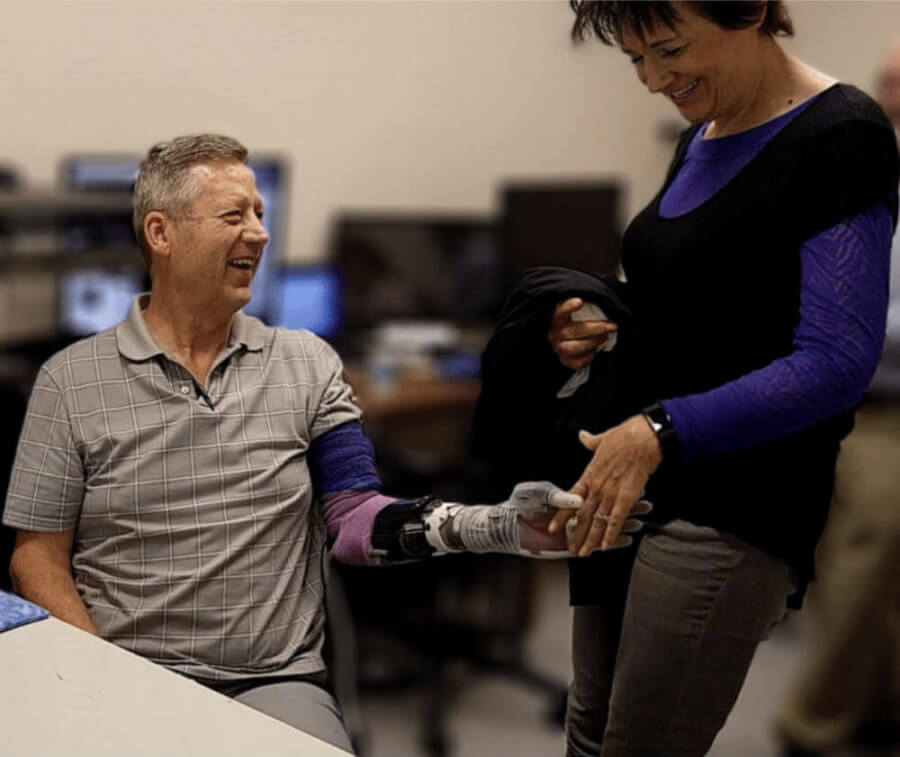Throughout
its history, prostheses have become more and more difficult: bionic hands perform various gripes, their knees bend and unbend themselves with effort, making walking on the stairs easier. But still one of the most important problems is the lack of feedback. Amputees have to focus mainly on vision, so using a prosthesis in the dark or searching for objects in a backpack is not the most effective occupation.
A team of scientists from the Cleveland Clinic has
presented a new way to get feedback from prostheses, based on the vibration in the muscles of the prosthetic limb. Within several minutes, according to the researchers, three amputees began to more effectively use prosthetic hands.

A team of researchers led by Paul Marasco (Paul D. Marasco) has developed a neuro-machine interface that transmits vibration into muscle muscles to improve control of prosthetic limbs. The system simulates kinesthesia - a sense of body position and movement of limbs, effort, strength and gravity. Scientists consider this approach the most effective strategy for increasing the efficiency of prosthetic use and improving the lives of patients.
The average healthy person is able to perform various movements, to control their actions in the dark or with closed eyes. Thanks to
proprioceptors in our muscles, ligaments, joints, we know where our arm or leg is at a specific moment, we can predict movement to the end point and change any parameters to achieve it - for example, increase strength. In the case of a prosthesis, a person focuses only on vision, which reduces the effectiveness of the device.
“Due to the lack of feedback, it is impossible to operate objects in the dark. I need to see the item to take it. When it is not visible - it is impossible to understand where it is located. By weight, in principle, you can feel. Therefore, there is hope for artificial leather and other developments in the field of feedback, ”
said Konstantin Deblikov, the owner of bionic prostheses BeBeonic and MyoFacil, in an interview with Geektimes.
The study, which was conducted by Paul Marasco, was attended by people with amputated hands, using invasive prostheses of the hands - devices connected directly to the nerves of the limb, allow them to be controlled intuitively using signals from the brain. During the experiment, the scientists installed vibrating devices on the stumps: the vibrations created the illusion of kinesthesia. The device made it possible not only to "feel" how the grip is compressed or unclenched, but also helped to intuitively manage the prosthesis without having to constantly look at it. Efficiency increased when vision was added to this process.
According to the team leader, Paul Marasco, scientists have been aware of the ability of muscle vibrations to create the illusion of kinaesthesia since the 1970s. But his team is amazed at how strongly this technique affects patients.
Below is a video showing the process of interaction with the prosthesis and receiving feedback through vibration.
In addition to improving control over the limb, feedback plays another important role: it is designed to eliminate the feeling of foreignness. “Having lost a limb, you not only lose physically a part of yourself, you also lose a part of the spiritual component,” says
Jacob George , the author of another study conducted in 2017. Then the thought-controlled prosthesis helped
restore 100 realistic tactile sensations .
Sensors installed in the prosthesis, send information to the brain through two implanted devices. The brain transforms them into feelings of pressure, vibration and movement. This allows you to fool the brain and make it think that the limb really belongs to this body.
In the photo below - one of the participants in the experiment holds and feels his wife's hand with the help of an experimental bionic prosthesis.

The scientific work was
published in the journal Science Transplantational Medicine in March 2018. DOI: 10.1126 / scitranslmed.aao6990